Data Analytics Portfolio: Data Analysis and Iteration at ICON College
VerifiedAdded on 2023/07/17
|20
|4579
|320
Report
AI Summary
This data analytics portfolio delves into various aspects of business operations, data management systems, and digital transformation, focusing on Volkswagen AG as a case study. The report begins by outlining the company's operations and business procedures, including flowcharts and maps of its production processes, key business decisions related to production plant location and inventory, and the implementation of digital transformation in human resources recruitment, inventory management, and client data custody. It then explores the data management systems employed by Volkswagen AG, such as Big Data, Catena-X, and cloud computing, emphasizing their role in connecting the company's facilities and supporting HR functions through applications like Hierology BI. Finally, the report discusses the opportunities for business intelligence (BI) tools within the organization, reflecting on their support and overall impact on decision-making and strategic planning. This portfolio provides a comprehensive overview of how data analytics can be applied to enhance business operations and drive strategic initiatives within a large multinational corporation. Desklib provides access to similar solved assignments and past papers for students.
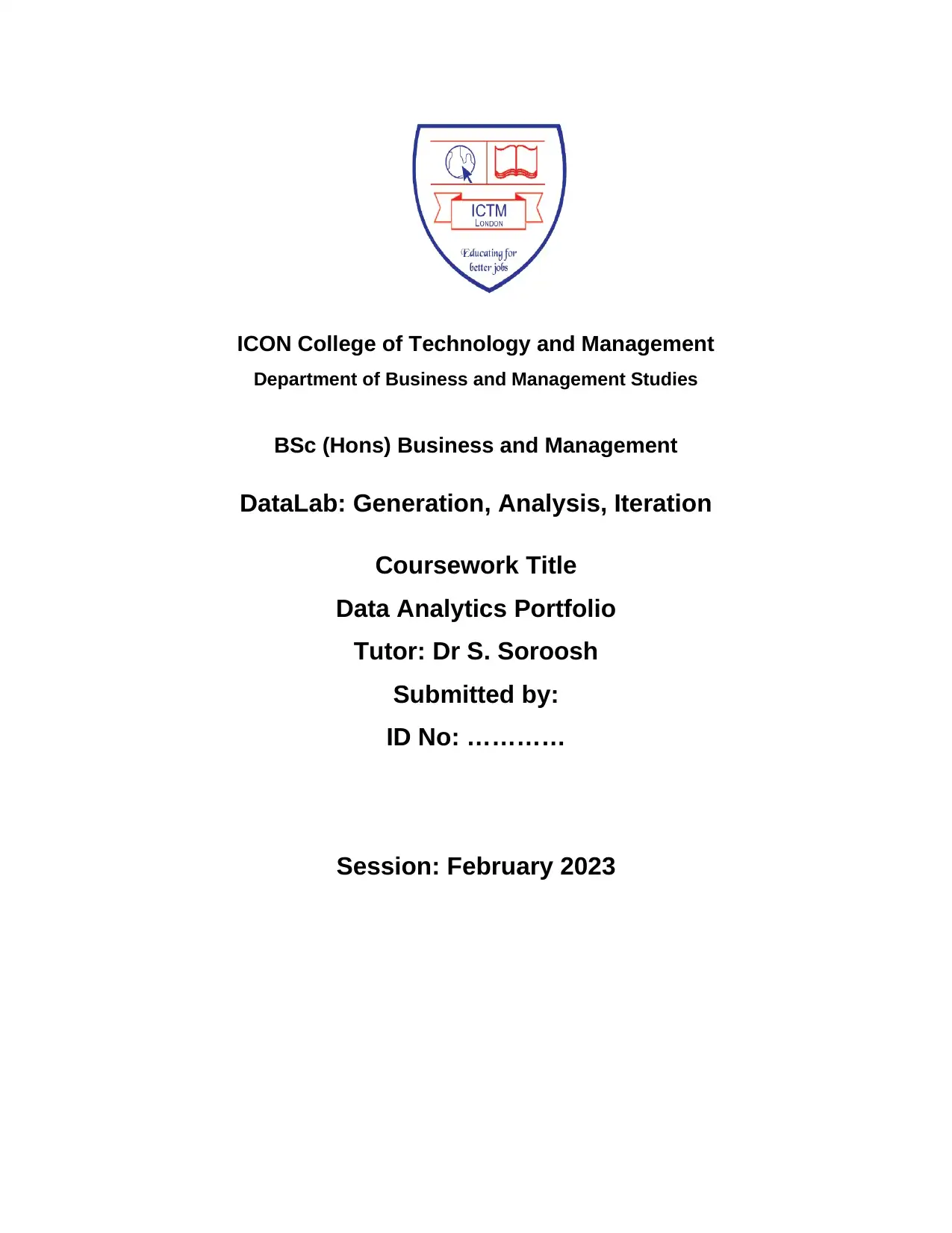
ICON College of Technology and Management
Department of Business and Management Studies
BSc (Hons) Business and Management
DataLab: Generation, Analysis, Iteration
Coursework Title
Data Analytics Portfolio
Tutor: Dr S. Soroosh
Submitted by:
ID No: …………
Session: February 2023
Department of Business and Management Studies
BSc (Hons) Business and Management
DataLab: Generation, Analysis, Iteration
Coursework Title
Data Analytics Portfolio
Tutor: Dr S. Soroosh
Submitted by:
ID No: …………
Session: February 2023
Paraphrase This Document
Need a fresh take? Get an instant paraphrase of this document with our AI Paraphraser
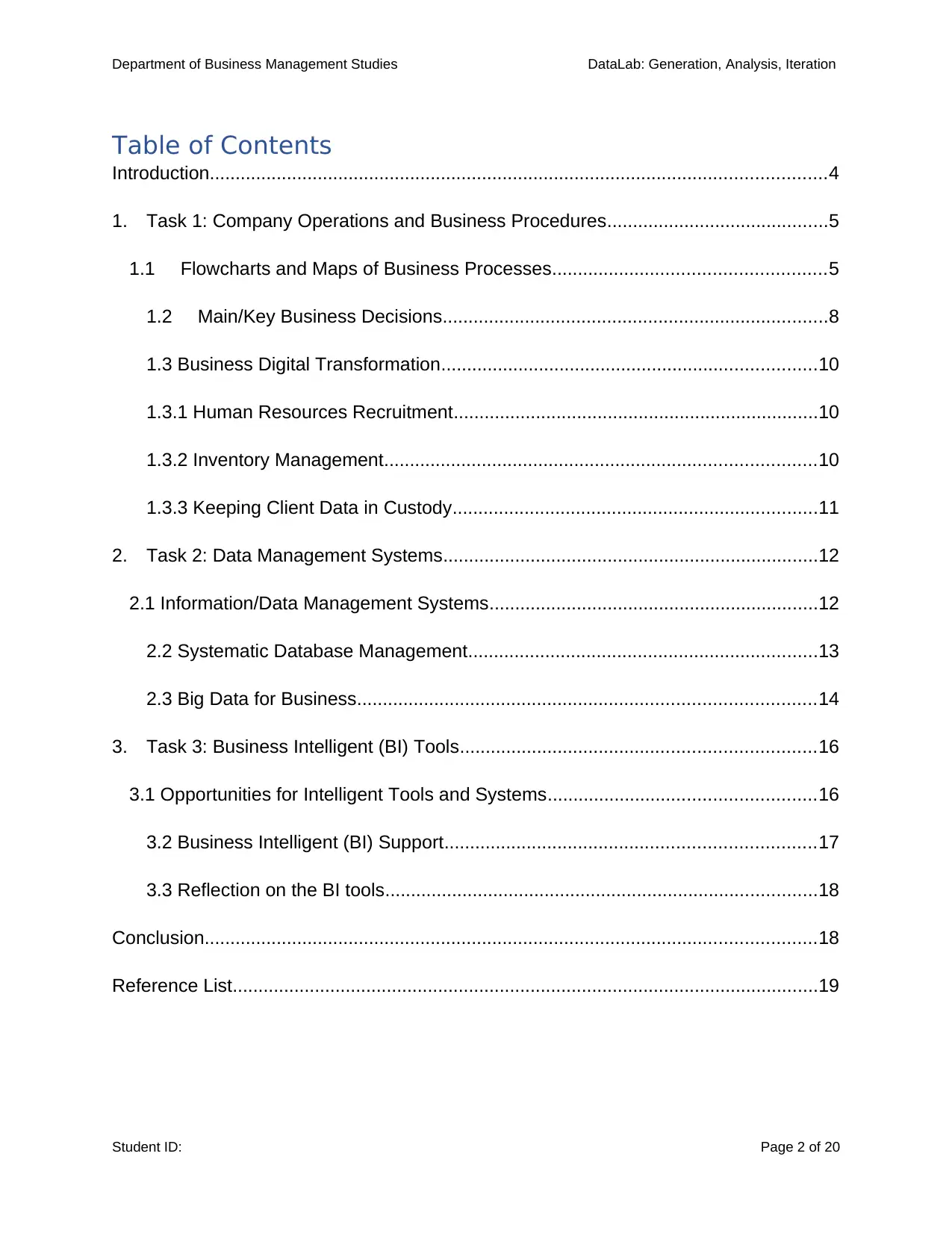
Department of Business Management Studies DataLab: Generation, Analysis, Iteration
Table of Contents
Introduction........................................................................................................................4
1. Task 1: Company Operations and Business Procedures...........................................5
1.1 Flowcharts and Maps of Business Processes.....................................................5
1.2 Main/Key Business Decisions...........................................................................8
1.3 Business Digital Transformation.........................................................................10
1.3.1 Human Resources Recruitment.......................................................................10
1.3.2 Inventory Management....................................................................................10
1.3.3 Keeping Client Data in Custody.......................................................................11
2. Task 2: Data Management Systems.........................................................................12
2.1 Information/Data Management Systems................................................................12
2.2 Systematic Database Management....................................................................13
2.3 Big Data for Business.........................................................................................14
3. Task 3: Business Intelligent (BI) Tools.....................................................................16
3.1 Opportunities for Intelligent Tools and Systems....................................................16
3.2 Business Intelligent (BI) Support........................................................................17
3.3 Reflection on the BI tools....................................................................................18
Conclusion.......................................................................................................................18
Reference List..................................................................................................................19
Student ID: Page 2 of 20
Table of Contents
Introduction........................................................................................................................4
1. Task 1: Company Operations and Business Procedures...........................................5
1.1 Flowcharts and Maps of Business Processes.....................................................5
1.2 Main/Key Business Decisions...........................................................................8
1.3 Business Digital Transformation.........................................................................10
1.3.1 Human Resources Recruitment.......................................................................10
1.3.2 Inventory Management....................................................................................10
1.3.3 Keeping Client Data in Custody.......................................................................11
2. Task 2: Data Management Systems.........................................................................12
2.1 Information/Data Management Systems................................................................12
2.2 Systematic Database Management....................................................................13
2.3 Big Data for Business.........................................................................................14
3. Task 3: Business Intelligent (BI) Tools.....................................................................16
3.1 Opportunities for Intelligent Tools and Systems....................................................16
3.2 Business Intelligent (BI) Support........................................................................17
3.3 Reflection on the BI tools....................................................................................18
Conclusion.......................................................................................................................18
Reference List..................................................................................................................19
Student ID: Page 2 of 20
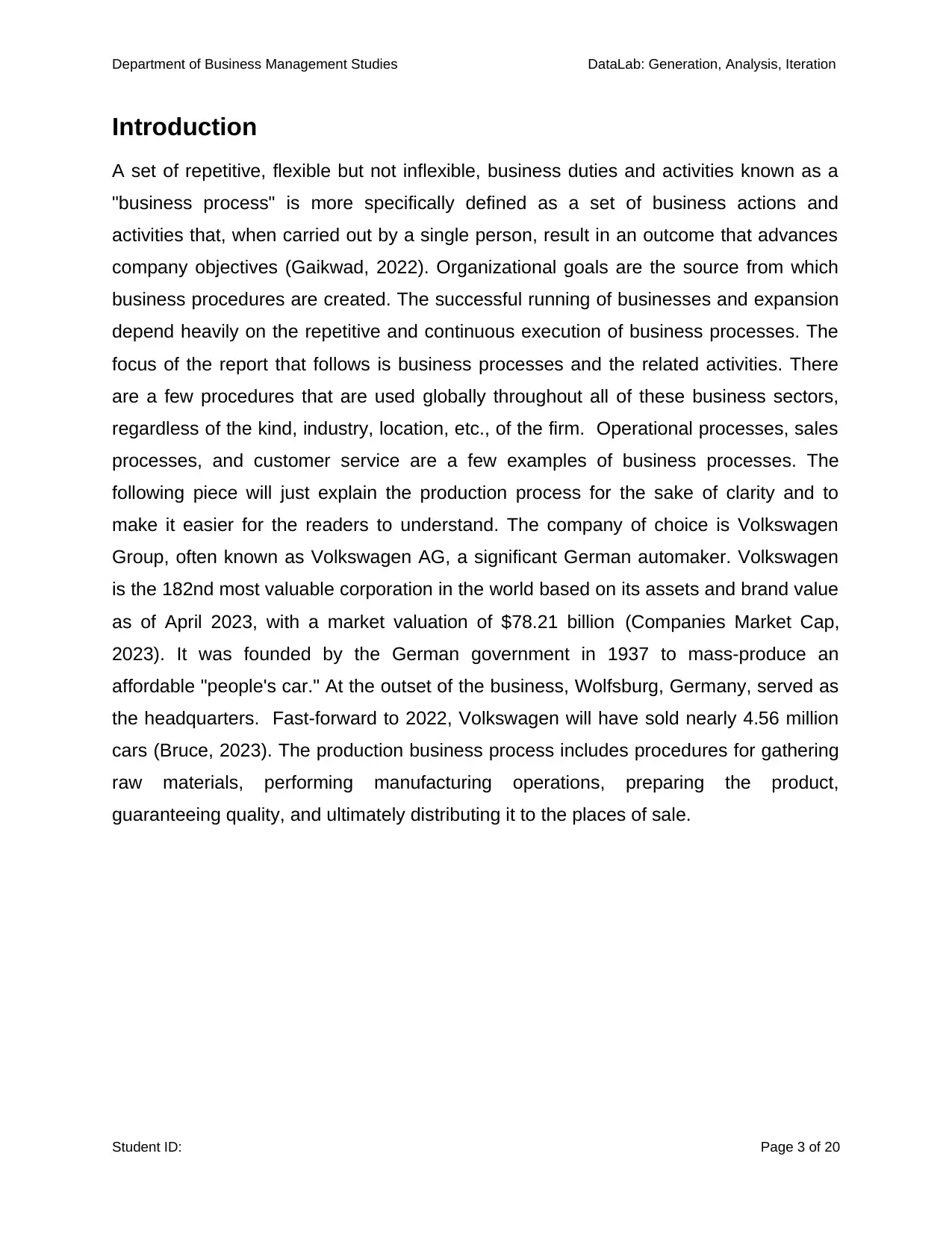
Department of Business Management Studies DataLab: Generation, Analysis, Iteration
Introduction
A set of repetitive, flexible but not inflexible, business duties and activities known as a
"business process" is more specifically defined as a set of business actions and
activities that, when carried out by a single person, result in an outcome that advances
company objectives (Gaikwad, 2022). Organizational goals are the source from which
business procedures are created. The successful running of businesses and expansion
depend heavily on the repetitive and continuous execution of business processes. The
focus of the report that follows is business processes and the related activities. There
are a few procedures that are used globally throughout all of these business sectors,
regardless of the kind, industry, location, etc., of the firm. Operational processes, sales
processes, and customer service are a few examples of business processes. The
following piece will just explain the production process for the sake of clarity and to
make it easier for the readers to understand. The company of choice is Volkswagen
Group, often known as Volkswagen AG, a significant German automaker. Volkswagen
is the 182nd most valuable corporation in the world based on its assets and brand value
as of April 2023, with a market valuation of $78.21 billion (Companies Market Cap,
2023). It was founded by the German government in 1937 to mass-produce an
affordable "people's car." At the outset of the business, Wolfsburg, Germany, served as
the headquarters. Fast-forward to 2022, Volkswagen will have sold nearly 4.56 million
cars (Bruce, 2023). The production business process includes procedures for gathering
raw materials, performing manufacturing operations, preparing the product,
guaranteeing quality, and ultimately distributing it to the places of sale.
Student ID: Page 3 of 20
Introduction
A set of repetitive, flexible but not inflexible, business duties and activities known as a
"business process" is more specifically defined as a set of business actions and
activities that, when carried out by a single person, result in an outcome that advances
company objectives (Gaikwad, 2022). Organizational goals are the source from which
business procedures are created. The successful running of businesses and expansion
depend heavily on the repetitive and continuous execution of business processes. The
focus of the report that follows is business processes and the related activities. There
are a few procedures that are used globally throughout all of these business sectors,
regardless of the kind, industry, location, etc., of the firm. Operational processes, sales
processes, and customer service are a few examples of business processes. The
following piece will just explain the production process for the sake of clarity and to
make it easier for the readers to understand. The company of choice is Volkswagen
Group, often known as Volkswagen AG, a significant German automaker. Volkswagen
is the 182nd most valuable corporation in the world based on its assets and brand value
as of April 2023, with a market valuation of $78.21 billion (Companies Market Cap,
2023). It was founded by the German government in 1937 to mass-produce an
affordable "people's car." At the outset of the business, Wolfsburg, Germany, served as
the headquarters. Fast-forward to 2022, Volkswagen will have sold nearly 4.56 million
cars (Bruce, 2023). The production business process includes procedures for gathering
raw materials, performing manufacturing operations, preparing the product,
guaranteeing quality, and ultimately distributing it to the places of sale.
Student ID: Page 3 of 20
⊘ This is a preview!⊘
Do you want full access?
Subscribe today to unlock all pages.

Trusted by 1+ million students worldwide
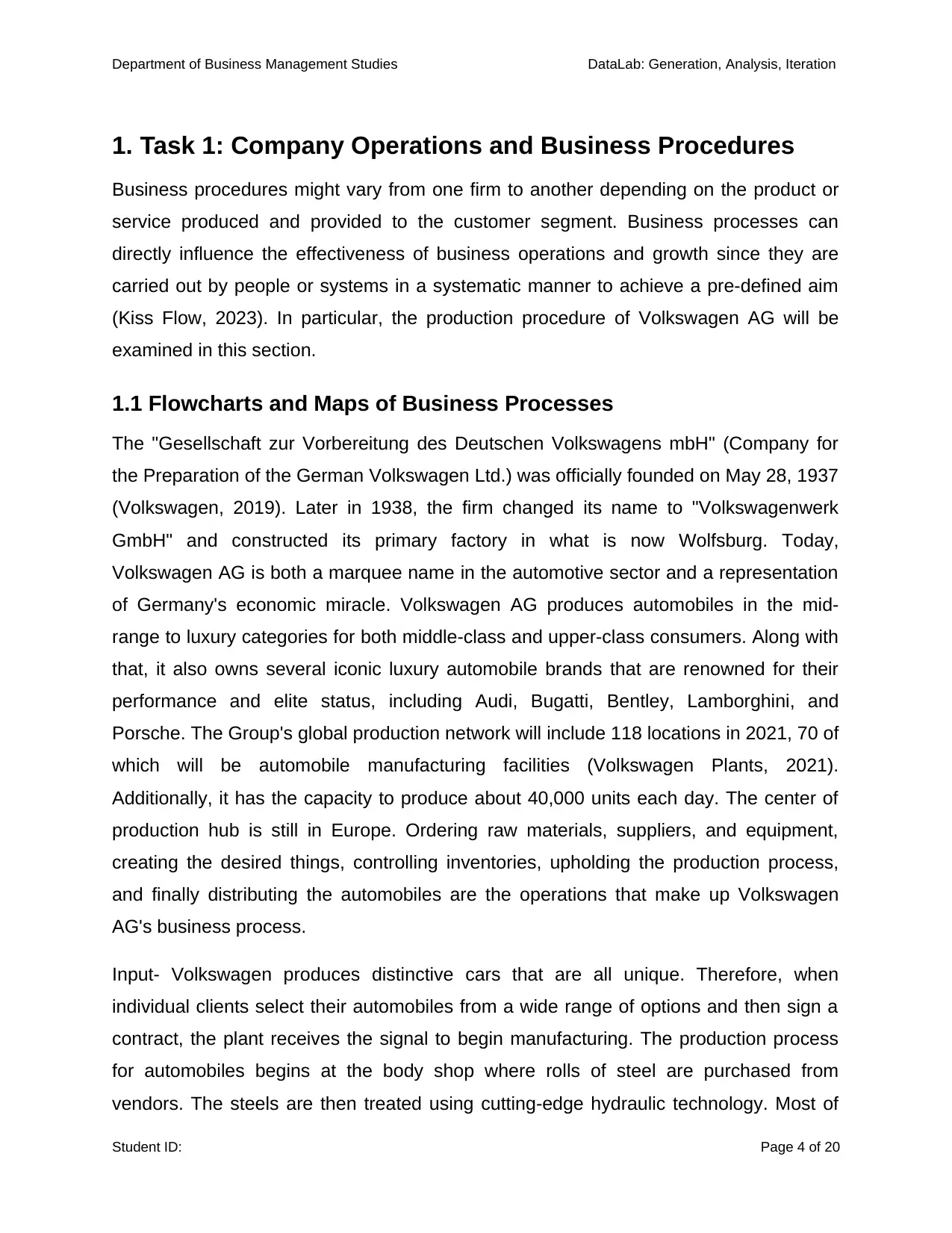
Department of Business Management Studies DataLab: Generation, Analysis, Iteration
1. Task 1: Company Operations and Business Procedures
Business procedures might vary from one firm to another depending on the product or
service produced and provided to the customer segment. Business processes can
directly influence the effectiveness of business operations and growth since they are
carried out by people or systems in a systematic manner to achieve a pre-defined aim
(Kiss Flow, 2023). In particular, the production procedure of Volkswagen AG will be
examined in this section.
1.1 Flowcharts and Maps of Business Processes
The "Gesellschaft zur Vorbereitung des Deutschen Volkswagens mbH" (Company for
the Preparation of the German Volkswagen Ltd.) was officially founded on May 28, 1937
(Volkswagen, 2019). Later in 1938, the firm changed its name to "Volkswagenwerk
GmbH" and constructed its primary factory in what is now Wolfsburg. Today,
Volkswagen AG is both a marquee name in the automotive sector and a representation
of Germany's economic miracle. Volkswagen AG produces automobiles in the mid-
range to luxury categories for both middle-class and upper-class consumers. Along with
that, it also owns several iconic luxury automobile brands that are renowned for their
performance and elite status, including Audi, Bugatti, Bentley, Lamborghini, and
Porsche. The Group's global production network will include 118 locations in 2021, 70 of
which will be automobile manufacturing facilities (Volkswagen Plants, 2021).
Additionally, it has the capacity to produce about 40,000 units each day. The center of
production hub is still in Europe. Ordering raw materials, suppliers, and equipment,
creating the desired things, controlling inventories, upholding the production process,
and finally distributing the automobiles are the operations that make up Volkswagen
AG's business process.
Input- Volkswagen produces distinctive cars that are all unique. Therefore, when
individual clients select their automobiles from a wide range of options and then sign a
contract, the plant receives the signal to begin manufacturing. The production process
for automobiles begins at the body shop where rolls of steel are purchased from
vendors. The steels are then treated using cutting-edge hydraulic technology. Most of
Student ID: Page 4 of 20
1. Task 1: Company Operations and Business Procedures
Business procedures might vary from one firm to another depending on the product or
service produced and provided to the customer segment. Business processes can
directly influence the effectiveness of business operations and growth since they are
carried out by people or systems in a systematic manner to achieve a pre-defined aim
(Kiss Flow, 2023). In particular, the production procedure of Volkswagen AG will be
examined in this section.
1.1 Flowcharts and Maps of Business Processes
The "Gesellschaft zur Vorbereitung des Deutschen Volkswagens mbH" (Company for
the Preparation of the German Volkswagen Ltd.) was officially founded on May 28, 1937
(Volkswagen, 2019). Later in 1938, the firm changed its name to "Volkswagenwerk
GmbH" and constructed its primary factory in what is now Wolfsburg. Today,
Volkswagen AG is both a marquee name in the automotive sector and a representation
of Germany's economic miracle. Volkswagen AG produces automobiles in the mid-
range to luxury categories for both middle-class and upper-class consumers. Along with
that, it also owns several iconic luxury automobile brands that are renowned for their
performance and elite status, including Audi, Bugatti, Bentley, Lamborghini, and
Porsche. The Group's global production network will include 118 locations in 2021, 70 of
which will be automobile manufacturing facilities (Volkswagen Plants, 2021).
Additionally, it has the capacity to produce about 40,000 units each day. The center of
production hub is still in Europe. Ordering raw materials, suppliers, and equipment,
creating the desired things, controlling inventories, upholding the production process,
and finally distributing the automobiles are the operations that make up Volkswagen
AG's business process.
Input- Volkswagen produces distinctive cars that are all unique. Therefore, when
individual clients select their automobiles from a wide range of options and then sign a
contract, the plant receives the signal to begin manufacturing. The production process
for automobiles begins at the body shop where rolls of steel are purchased from
vendors. The steels are then treated using cutting-edge hydraulic technology. Most of
Student ID: Page 4 of 20
Paraphrase This Document
Need a fresh take? Get an instant paraphrase of this document with our AI Paraphraser
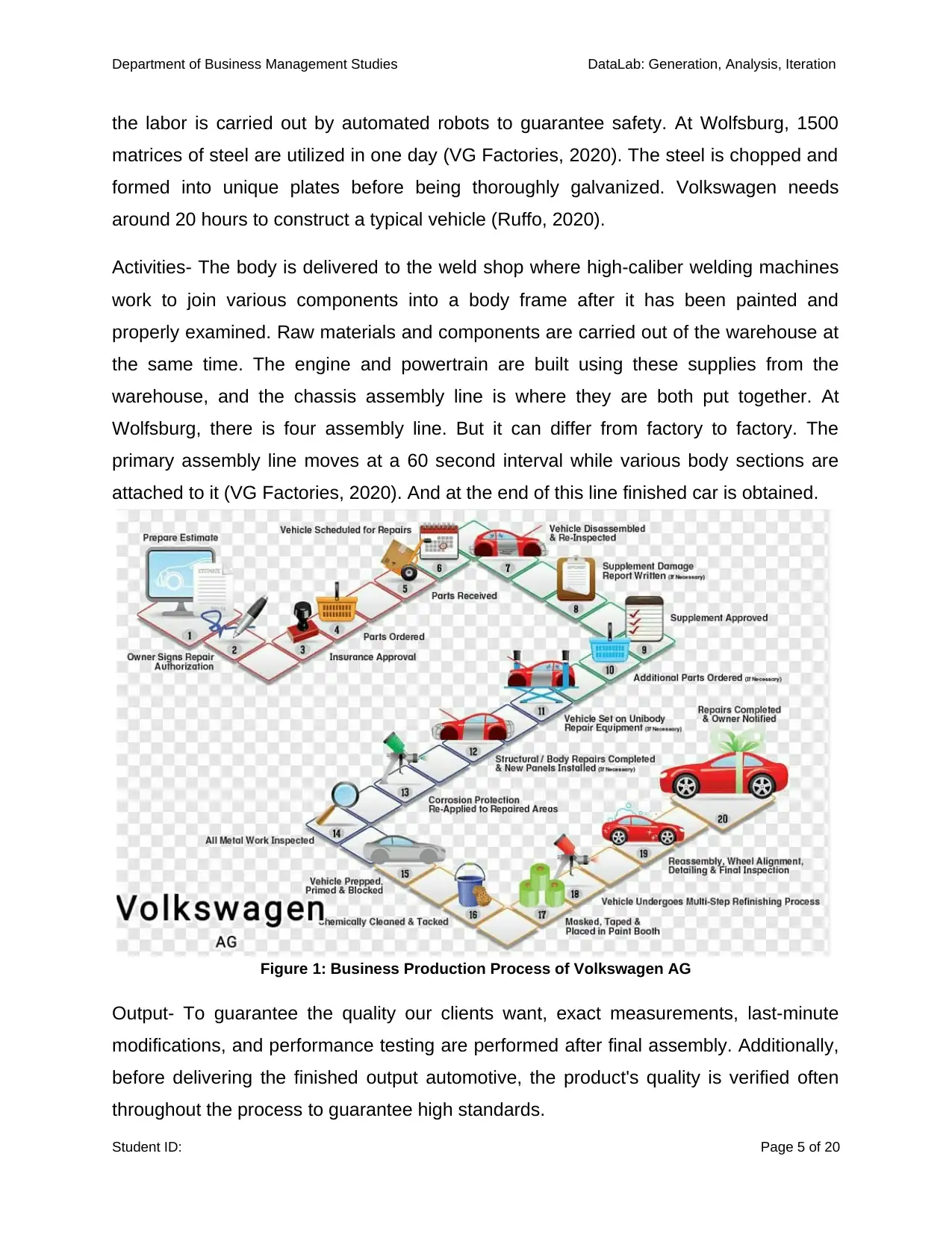
Department of Business Management Studies DataLab: Generation, Analysis, Iteration
the labor is carried out by automated robots to guarantee safety. At Wolfsburg, 1500
matrices of steel are utilized in one day (VG Factories, 2020). The steel is chopped and
formed into unique plates before being thoroughly galvanized. Volkswagen needs
around 20 hours to construct a typical vehicle (Ruffo, 2020).
Activities- The body is delivered to the weld shop where high-caliber welding machines
work to join various components into a body frame after it has been painted and
properly examined. Raw materials and components are carried out of the warehouse at
the same time. The engine and powertrain are built using these supplies from the
warehouse, and the chassis assembly line is where they are both put together. At
Wolfsburg, there is four assembly line. But it can differ from factory to factory. The
primary assembly line moves at a 60 second interval while various body sections are
attached to it (VG Factories, 2020). And at the end of this line finished car is obtained.
Figure 1: Business Production Process of Volkswagen AG
Output- To guarantee the quality our clients want, exact measurements, last-minute
modifications, and performance testing are performed after final assembly. Additionally,
before delivering the finished output automotive, the product's quality is verified often
throughout the process to guarantee high standards.
Student ID: Page 5 of 20
the labor is carried out by automated robots to guarantee safety. At Wolfsburg, 1500
matrices of steel are utilized in one day (VG Factories, 2020). The steel is chopped and
formed into unique plates before being thoroughly galvanized. Volkswagen needs
around 20 hours to construct a typical vehicle (Ruffo, 2020).
Activities- The body is delivered to the weld shop where high-caliber welding machines
work to join various components into a body frame after it has been painted and
properly examined. Raw materials and components are carried out of the warehouse at
the same time. The engine and powertrain are built using these supplies from the
warehouse, and the chassis assembly line is where they are both put together. At
Wolfsburg, there is four assembly line. But it can differ from factory to factory. The
primary assembly line moves at a 60 second interval while various body sections are
attached to it (VG Factories, 2020). And at the end of this line finished car is obtained.
Figure 1: Business Production Process of Volkswagen AG
Output- To guarantee the quality our clients want, exact measurements, last-minute
modifications, and performance testing are performed after final assembly. Additionally,
before delivering the finished output automotive, the product's quality is verified often
throughout the process to guarantee high standards.
Student ID: Page 5 of 20
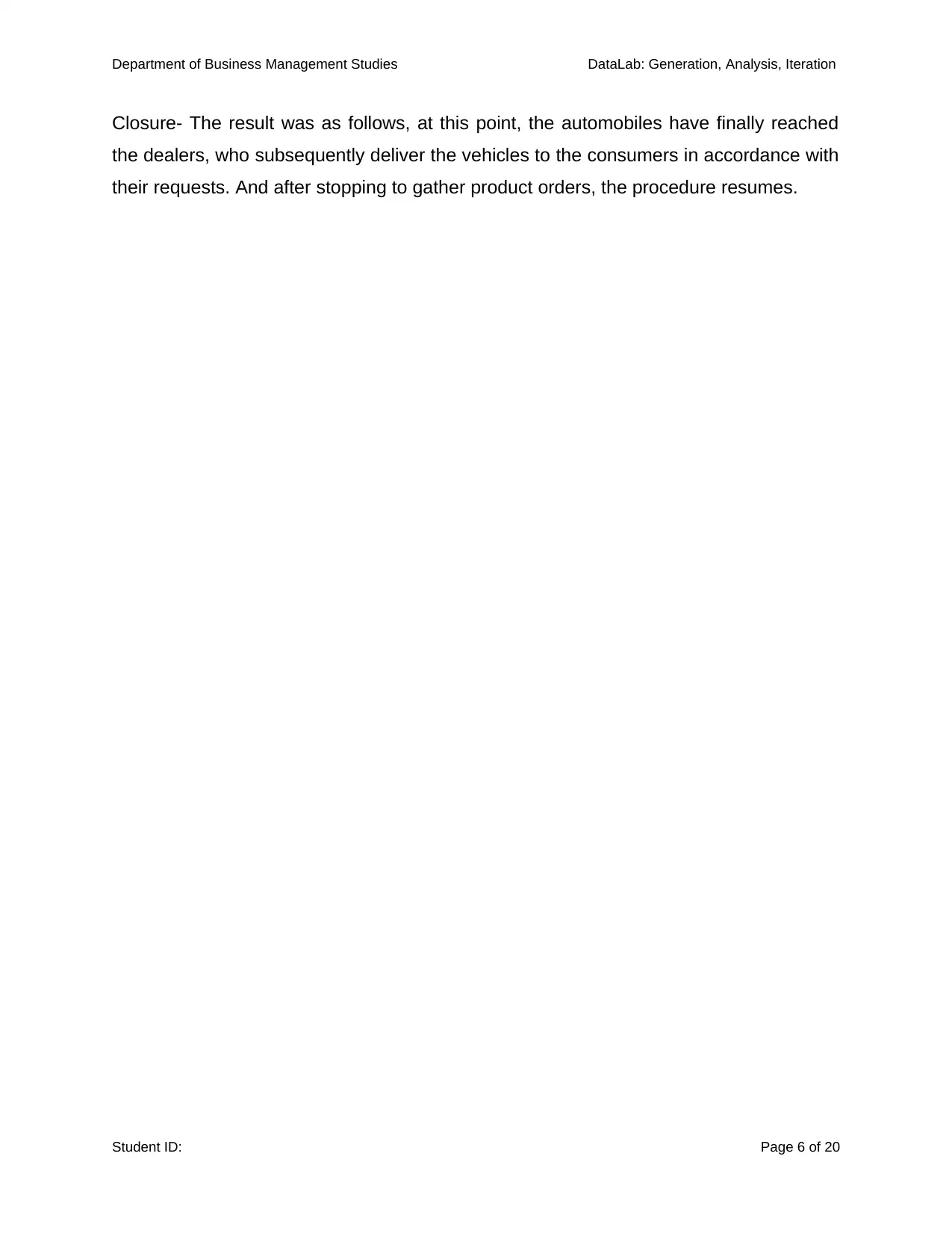
Department of Business Management Studies DataLab: Generation, Analysis, Iteration
Closure- The result was as follows, at this point, the automobiles have finally reached
the dealers, who subsequently deliver the vehicles to the consumers in accordance with
their requests. And after stopping to gather product orders, the procedure resumes.
Student ID: Page 6 of 20
Closure- The result was as follows, at this point, the automobiles have finally reached
the dealers, who subsequently deliver the vehicles to the consumers in accordance with
their requests. And after stopping to gather product orders, the procedure resumes.
Student ID: Page 6 of 20
⊘ This is a preview!⊘
Do you want full access?
Subscribe today to unlock all pages.

Trusted by 1+ million students worldwide
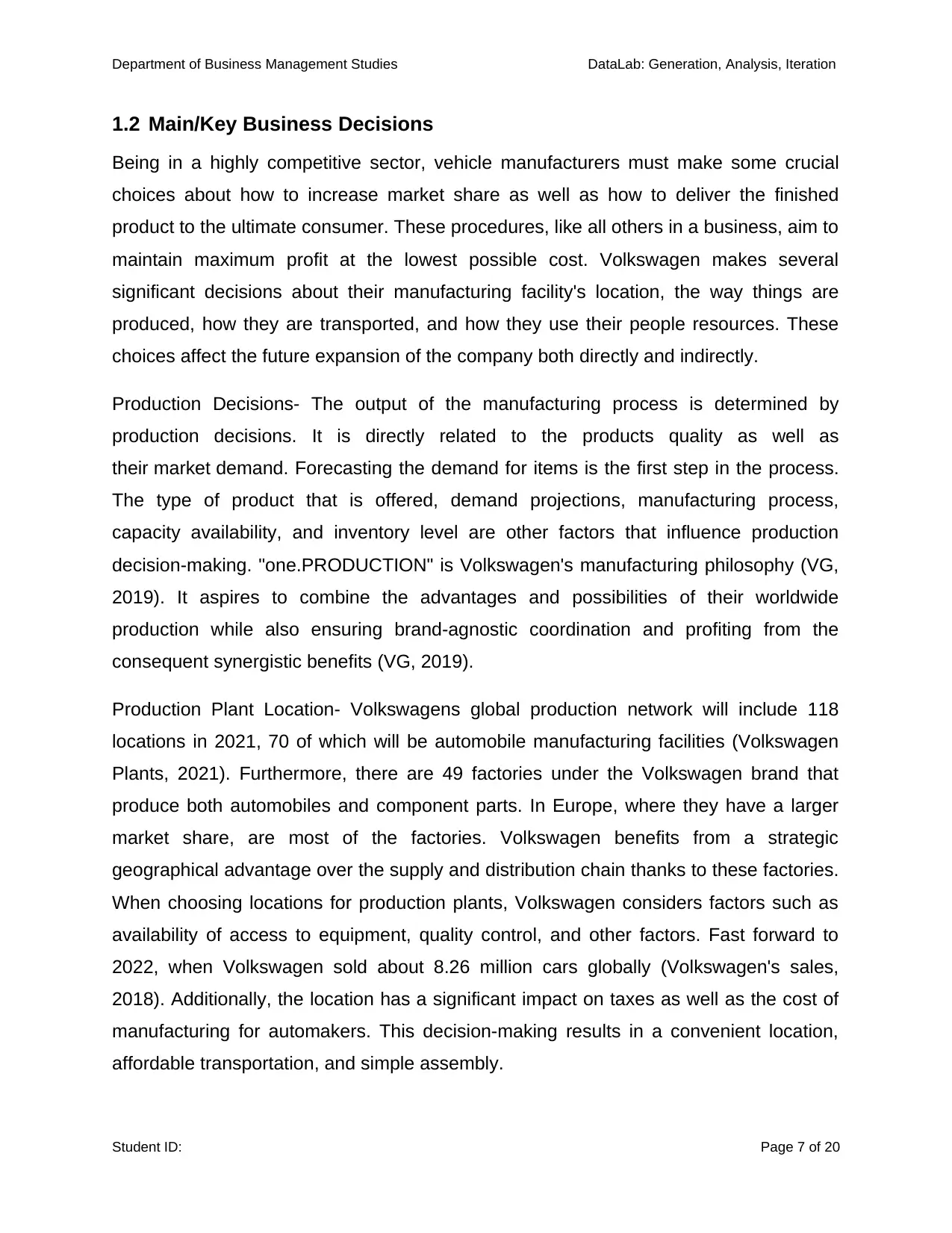
Department of Business Management Studies DataLab: Generation, Analysis, Iteration
1.2 Main/Key Business Decisions
Being in a highly competitive sector, vehicle manufacturers must make some crucial
choices about how to increase market share as well as how to deliver the finished
product to the ultimate consumer. These procedures, like all others in a business, aim to
maintain maximum profit at the lowest possible cost. Volkswagen makes several
significant decisions about their manufacturing facility's location, the way things are
produced, how they are transported, and how they use their people resources. These
choices affect the future expansion of the company both directly and indirectly.
Production Decisions- The output of the manufacturing process is determined by
production decisions. It is directly related to the products quality as well as
their market demand. Forecasting the demand for items is the first step in the process.
The type of product that is offered, demand projections, manufacturing process,
capacity availability, and inventory level are other factors that influence production
decision-making. "one.PRODUCTION" is Volkswagen's manufacturing philosophy (VG,
2019). It aspires to combine the advantages and possibilities of their worldwide
production while also ensuring brand-agnostic coordination and profiting from the
consequent synergistic benefits (VG, 2019).
Production Plant Location- Volkswagens global production network will include 118
locations in 2021, 70 of which will be automobile manufacturing facilities (Volkswagen
Plants, 2021). Furthermore, there are 49 factories under the Volkswagen brand that
produce both automobiles and component parts. In Europe, where they have a larger
market share, are most of the factories. Volkswagen benefits from a strategic
geographical advantage over the supply and distribution chain thanks to these factories.
When choosing locations for production plants, Volkswagen considers factors such as
availability of access to equipment, quality control, and other factors. Fast forward to
2022, when Volkswagen sold about 8.26 million cars globally (Volkswagen's sales,
2018). Additionally, the location has a significant impact on taxes as well as the cost of
manufacturing for automakers. This decision-making results in a convenient location,
affordable transportation, and simple assembly.
Student ID: Page 7 of 20
1.2 Main/Key Business Decisions
Being in a highly competitive sector, vehicle manufacturers must make some crucial
choices about how to increase market share as well as how to deliver the finished
product to the ultimate consumer. These procedures, like all others in a business, aim to
maintain maximum profit at the lowest possible cost. Volkswagen makes several
significant decisions about their manufacturing facility's location, the way things are
produced, how they are transported, and how they use their people resources. These
choices affect the future expansion of the company both directly and indirectly.
Production Decisions- The output of the manufacturing process is determined by
production decisions. It is directly related to the products quality as well as
their market demand. Forecasting the demand for items is the first step in the process.
The type of product that is offered, demand projections, manufacturing process,
capacity availability, and inventory level are other factors that influence production
decision-making. "one.PRODUCTION" is Volkswagen's manufacturing philosophy (VG,
2019). It aspires to combine the advantages and possibilities of their worldwide
production while also ensuring brand-agnostic coordination and profiting from the
consequent synergistic benefits (VG, 2019).
Production Plant Location- Volkswagens global production network will include 118
locations in 2021, 70 of which will be automobile manufacturing facilities (Volkswagen
Plants, 2021). Furthermore, there are 49 factories under the Volkswagen brand that
produce both automobiles and component parts. In Europe, where they have a larger
market share, are most of the factories. Volkswagen benefits from a strategic
geographical advantage over the supply and distribution chain thanks to these factories.
When choosing locations for production plants, Volkswagen considers factors such as
availability of access to equipment, quality control, and other factors. Fast forward to
2022, when Volkswagen sold about 8.26 million cars globally (Volkswagen's sales,
2018). Additionally, the location has a significant impact on taxes as well as the cost of
manufacturing for automakers. This decision-making results in a convenient location,
affordable transportation, and simple assembly.
Student ID: Page 7 of 20
Paraphrase This Document
Need a fresh take? Get an instant paraphrase of this document with our AI Paraphraser
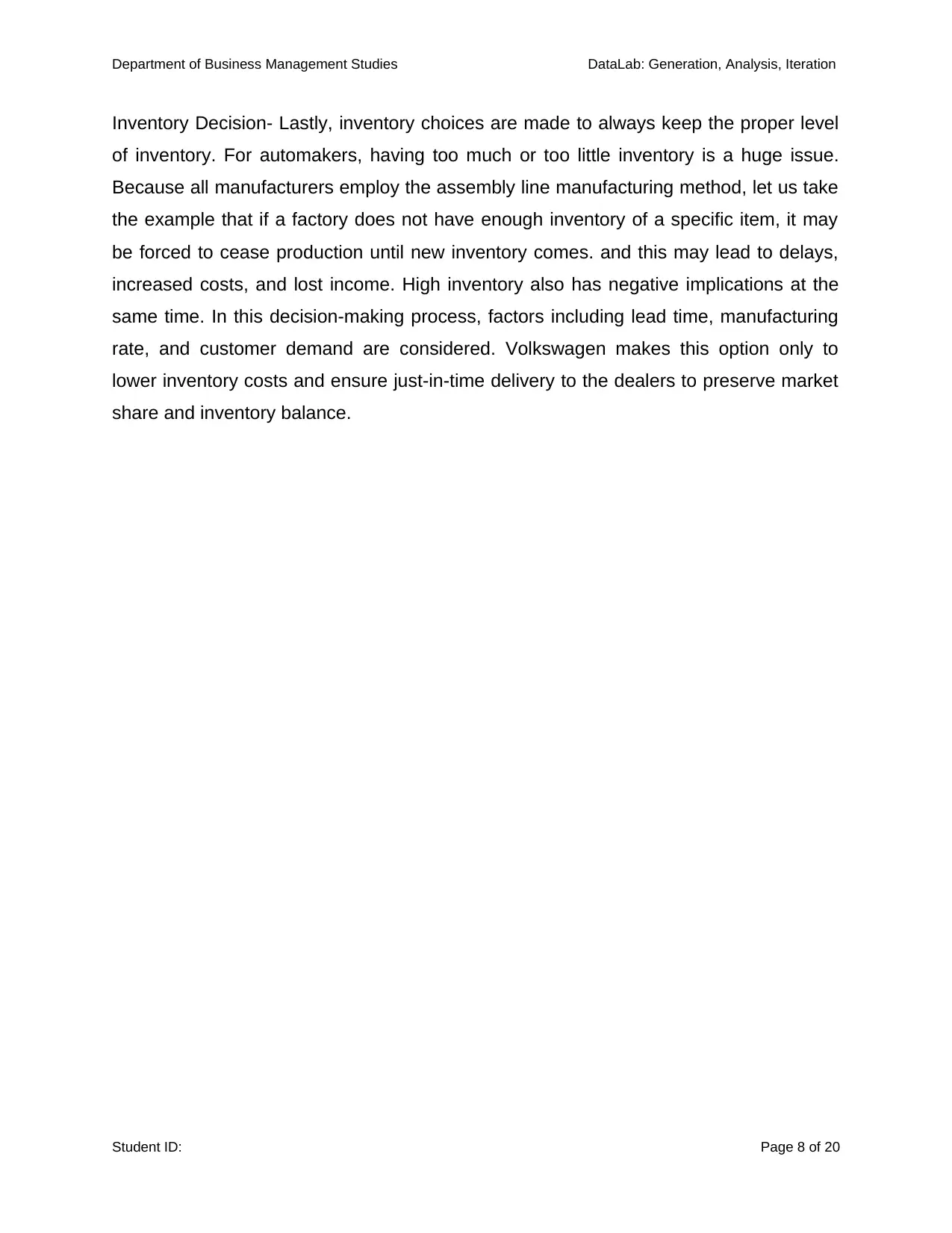
Department of Business Management Studies DataLab: Generation, Analysis, Iteration
Inventory Decision- Lastly, inventory choices are made to always keep the proper level
of inventory. For automakers, having too much or too little inventory is a huge issue.
Because all manufacturers employ the assembly line manufacturing method, let us take
the example that if a factory does not have enough inventory of a specific item, it may
be forced to cease production until new inventory comes. and this may lead to delays,
increased costs, and lost income. High inventory also has negative implications at the
same time. In this decision-making process, factors including lead time, manufacturing
rate, and customer demand are considered. Volkswagen makes this option only to
lower inventory costs and ensure just-in-time delivery to the dealers to preserve market
share and inventory balance.
Student ID: Page 8 of 20
Inventory Decision- Lastly, inventory choices are made to always keep the proper level
of inventory. For automakers, having too much or too little inventory is a huge issue.
Because all manufacturers employ the assembly line manufacturing method, let us take
the example that if a factory does not have enough inventory of a specific item, it may
be forced to cease production until new inventory comes. and this may lead to delays,
increased costs, and lost income. High inventory also has negative implications at the
same time. In this decision-making process, factors including lead time, manufacturing
rate, and customer demand are considered. Volkswagen makes this option only to
lower inventory costs and ensure just-in-time delivery to the dealers to preserve market
share and inventory balance.
Student ID: Page 8 of 20
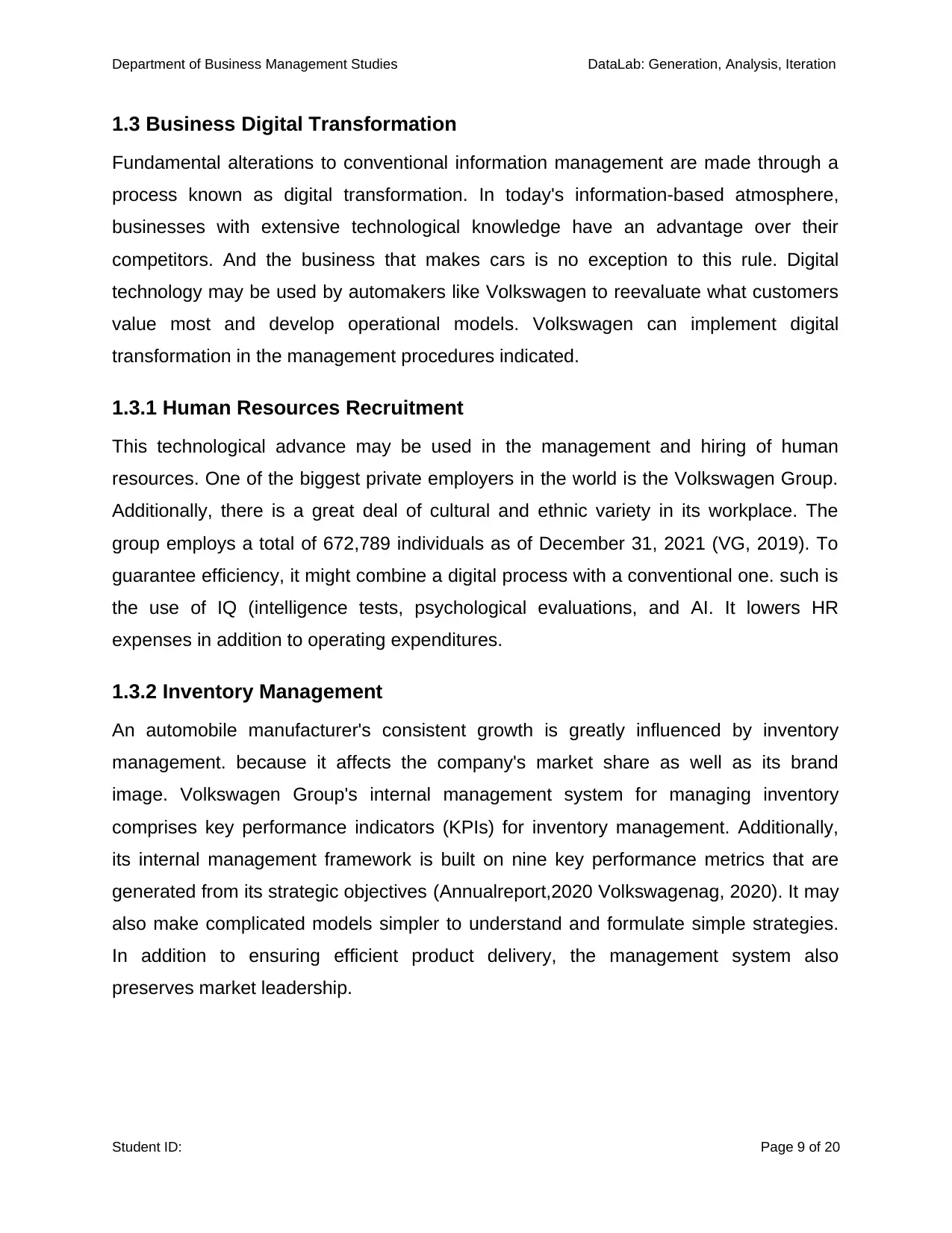
Department of Business Management Studies DataLab: Generation, Analysis, Iteration
1.3 Business Digital Transformation
Fundamental alterations to conventional information management are made through a
process known as digital transformation. In today's information-based atmosphere,
businesses with extensive technological knowledge have an advantage over their
competitors. And the business that makes cars is no exception to this rule. Digital
technology may be used by automakers like Volkswagen to reevaluate what customers
value most and develop operational models. Volkswagen can implement digital
transformation in the management procedures indicated.
1.3.1 Human Resources Recruitment
This technological advance may be used in the management and hiring of human
resources. One of the biggest private employers in the world is the Volkswagen Group.
Additionally, there is a great deal of cultural and ethnic variety in its workplace. The
group employs a total of 672,789 individuals as of December 31, 2021 (VG, 2019). To
guarantee efficiency, it might combine a digital process with a conventional one. such is
the use of IQ (intelligence tests, psychological evaluations, and AI. It lowers HR
expenses in addition to operating expenditures.
1.3.2 Inventory Management
An automobile manufacturer's consistent growth is greatly influenced by inventory
management. because it affects the company's market share as well as its brand
image. Volkswagen Group's internal management system for managing inventory
comprises key performance indicators (KPIs) for inventory management. Additionally,
its internal management framework is built on nine key performance metrics that are
generated from its strategic objectives (Annualreport,2020 Volkswagenag, 2020). It may
also make complicated models simpler to understand and formulate simple strategies.
In addition to ensuring efficient product delivery, the management system also
preserves market leadership.
Student ID: Page 9 of 20
1.3 Business Digital Transformation
Fundamental alterations to conventional information management are made through a
process known as digital transformation. In today's information-based atmosphere,
businesses with extensive technological knowledge have an advantage over their
competitors. And the business that makes cars is no exception to this rule. Digital
technology may be used by automakers like Volkswagen to reevaluate what customers
value most and develop operational models. Volkswagen can implement digital
transformation in the management procedures indicated.
1.3.1 Human Resources Recruitment
This technological advance may be used in the management and hiring of human
resources. One of the biggest private employers in the world is the Volkswagen Group.
Additionally, there is a great deal of cultural and ethnic variety in its workplace. The
group employs a total of 672,789 individuals as of December 31, 2021 (VG, 2019). To
guarantee efficiency, it might combine a digital process with a conventional one. such is
the use of IQ (intelligence tests, psychological evaluations, and AI. It lowers HR
expenses in addition to operating expenditures.
1.3.2 Inventory Management
An automobile manufacturer's consistent growth is greatly influenced by inventory
management. because it affects the company's market share as well as its brand
image. Volkswagen Group's internal management system for managing inventory
comprises key performance indicators (KPIs) for inventory management. Additionally,
its internal management framework is built on nine key performance metrics that are
generated from its strategic objectives (Annualreport,2020 Volkswagenag, 2020). It may
also make complicated models simpler to understand and formulate simple strategies.
In addition to ensuring efficient product delivery, the management system also
preserves market leadership.
Student ID: Page 9 of 20
⊘ This is a preview!⊘
Do you want full access?
Subscribe today to unlock all pages.

Trusted by 1+ million students worldwide
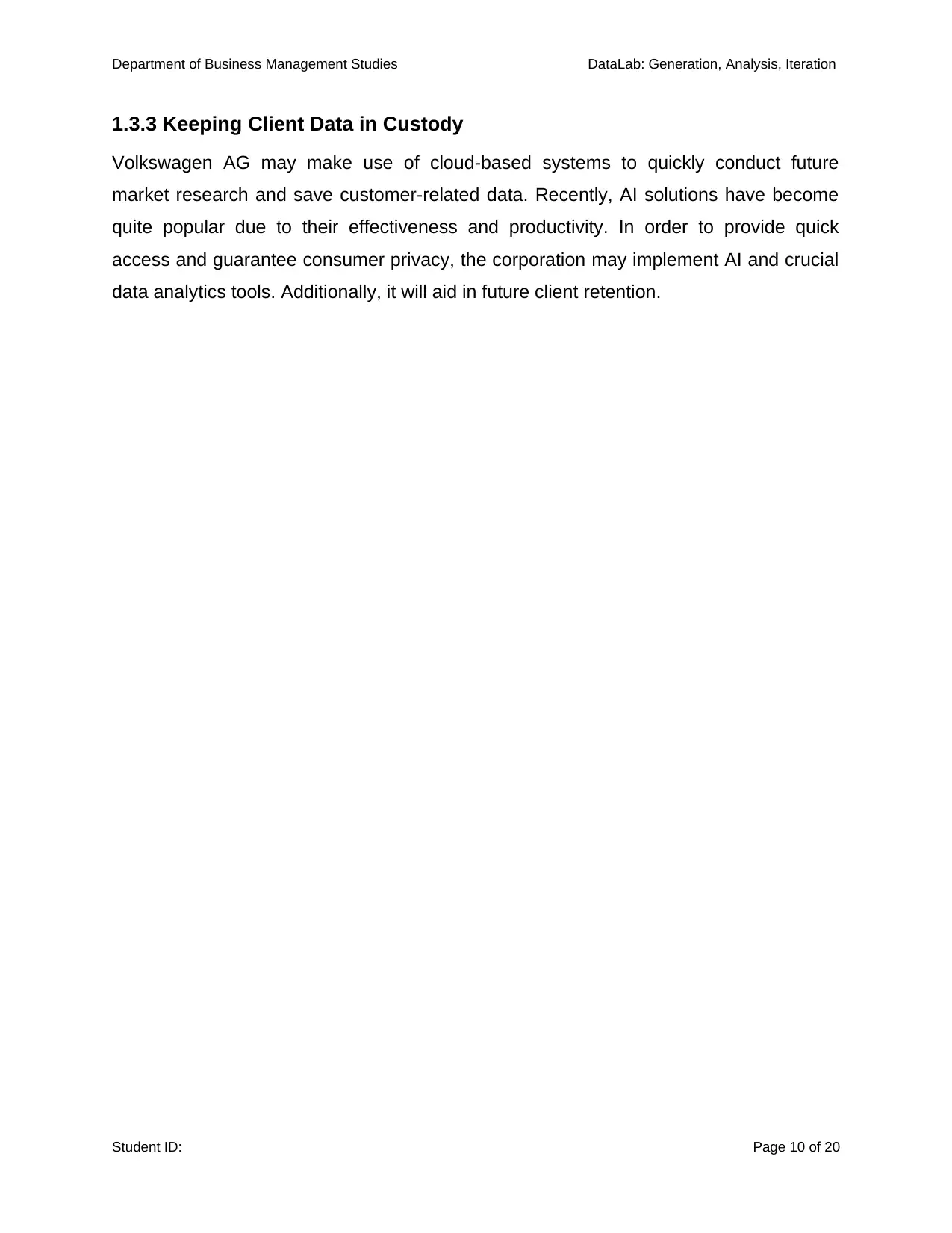
Department of Business Management Studies DataLab: Generation, Analysis, Iteration
1.3.3 Keeping Client Data in Custody
Volkswagen AG may make use of cloud-based systems to quickly conduct future
market research and save customer-related data. Recently, AI solutions have become
quite popular due to their effectiveness and productivity. In order to provide quick
access and guarantee consumer privacy, the corporation may implement AI and crucial
data analytics tools. Additionally, it will aid in future client retention.
Student ID: Page 10 of 20
1.3.3 Keeping Client Data in Custody
Volkswagen AG may make use of cloud-based systems to quickly conduct future
market research and save customer-related data. Recently, AI solutions have become
quite popular due to their effectiveness and productivity. In order to provide quick
access and guarantee consumer privacy, the corporation may implement AI and crucial
data analytics tools. Additionally, it will aid in future client retention.
Student ID: Page 10 of 20
Paraphrase This Document
Need a fresh take? Get an instant paraphrase of this document with our AI Paraphraser
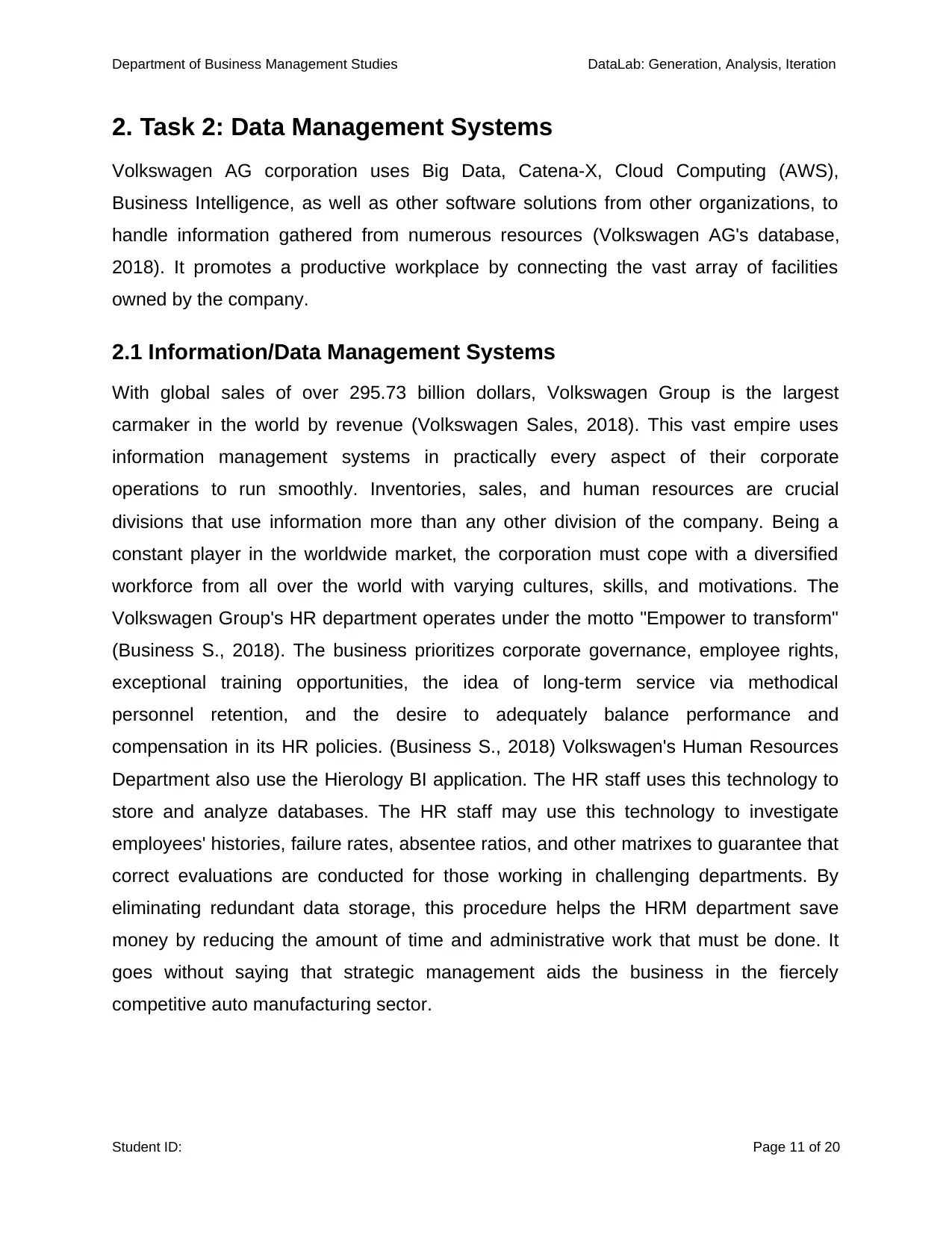
Department of Business Management Studies DataLab: Generation, Analysis, Iteration
2. Task 2: Data Management Systems
Volkswagen AG corporation uses Big Data, Catena-X, Cloud Computing (AWS),
Business Intelligence, as well as other software solutions from other organizations, to
handle information gathered from numerous resources (Volkswagen AG's database,
2018). It promotes a productive workplace by connecting the vast array of facilities
owned by the company.
2.1 Information/Data Management Systems
With global sales of over 295.73 billion dollars, Volkswagen Group is the largest
carmaker in the world by revenue (Volkswagen Sales, 2018). This vast empire uses
information management systems in practically every aspect of their corporate
operations to run smoothly. Inventories, sales, and human resources are crucial
divisions that use information more than any other division of the company. Being a
constant player in the worldwide market, the corporation must cope with a diversified
workforce from all over the world with varying cultures, skills, and motivations. The
Volkswagen Group's HR department operates under the motto "Empower to transform"
(Business S., 2018). The business prioritizes corporate governance, employee rights,
exceptional training opportunities, the idea of long-term service via methodical
personnel retention, and the desire to adequately balance performance and
compensation in its HR policies. (Business S., 2018) Volkswagen's Human Resources
Department also use the Hierology BI application. The HR staff uses this technology to
store and analyze databases. The HR staff may use this technology to investigate
employees' histories, failure rates, absentee ratios, and other matrixes to guarantee that
correct evaluations are conducted for those working in challenging departments. By
eliminating redundant data storage, this procedure helps the HRM department save
money by reducing the amount of time and administrative work that must be done. It
goes without saying that strategic management aids the business in the fiercely
competitive auto manufacturing sector.
Student ID: Page 11 of 20
2. Task 2: Data Management Systems
Volkswagen AG corporation uses Big Data, Catena-X, Cloud Computing (AWS),
Business Intelligence, as well as other software solutions from other organizations, to
handle information gathered from numerous resources (Volkswagen AG's database,
2018). It promotes a productive workplace by connecting the vast array of facilities
owned by the company.
2.1 Information/Data Management Systems
With global sales of over 295.73 billion dollars, Volkswagen Group is the largest
carmaker in the world by revenue (Volkswagen Sales, 2018). This vast empire uses
information management systems in practically every aspect of their corporate
operations to run smoothly. Inventories, sales, and human resources are crucial
divisions that use information more than any other division of the company. Being a
constant player in the worldwide market, the corporation must cope with a diversified
workforce from all over the world with varying cultures, skills, and motivations. The
Volkswagen Group's HR department operates under the motto "Empower to transform"
(Business S., 2018). The business prioritizes corporate governance, employee rights,
exceptional training opportunities, the idea of long-term service via methodical
personnel retention, and the desire to adequately balance performance and
compensation in its HR policies. (Business S., 2018) Volkswagen's Human Resources
Department also use the Hierology BI application. The HR staff uses this technology to
store and analyze databases. The HR staff may use this technology to investigate
employees' histories, failure rates, absentee ratios, and other matrixes to guarantee that
correct evaluations are conducted for those working in challenging departments. By
eliminating redundant data storage, this procedure helps the HRM department save
money by reducing the amount of time and administrative work that must be done. It
goes without saying that strategic management aids the business in the fiercely
competitive auto manufacturing sector.
Student ID: Page 11 of 20
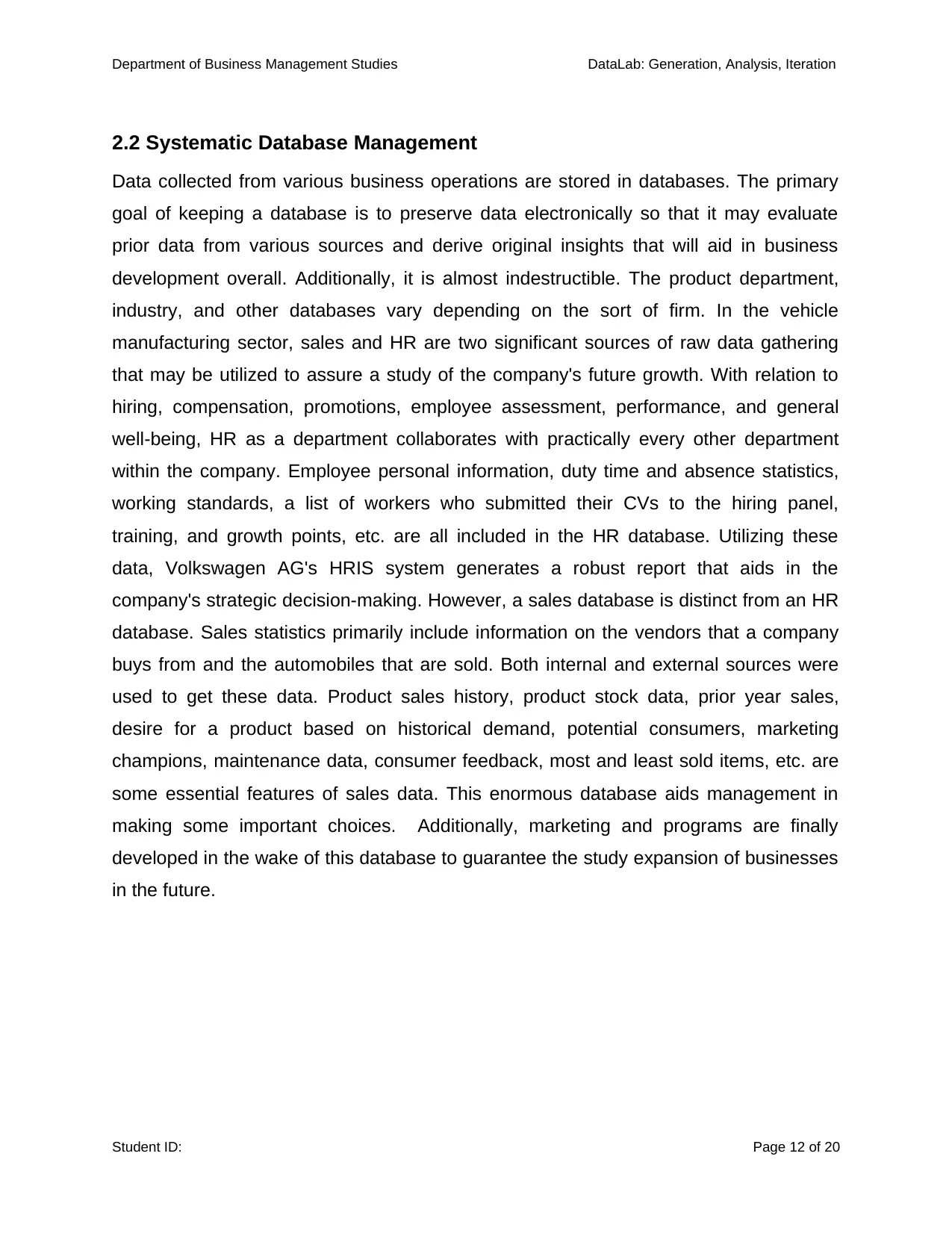
Department of Business Management Studies DataLab: Generation, Analysis, Iteration
2.2 Systematic Database Management
Data collected from various business operations are stored in databases. The primary
goal of keeping a database is to preserve data electronically so that it may evaluate
prior data from various sources and derive original insights that will aid in business
development overall. Additionally, it is almost indestructible. The product department,
industry, and other databases vary depending on the sort of firm. In the vehicle
manufacturing sector, sales and HR are two significant sources of raw data gathering
that may be utilized to assure a study of the company's future growth. With relation to
hiring, compensation, promotions, employee assessment, performance, and general
well-being, HR as a department collaborates with practically every other department
within the company. Employee personal information, duty time and absence statistics,
working standards, a list of workers who submitted their CVs to the hiring panel,
training, and growth points, etc. are all included in the HR database. Utilizing these
data, Volkswagen AG's HRIS system generates a robust report that aids in the
company's strategic decision-making. However, a sales database is distinct from an HR
database. Sales statistics primarily include information on the vendors that a company
buys from and the automobiles that are sold. Both internal and external sources were
used to get these data. Product sales history, product stock data, prior year sales,
desire for a product based on historical demand, potential consumers, marketing
champions, maintenance data, consumer feedback, most and least sold items, etc. are
some essential features of sales data. This enormous database aids management in
making some important choices. Additionally, marketing and programs are finally
developed in the wake of this database to guarantee the study expansion of businesses
in the future.
Student ID: Page 12 of 20
2.2 Systematic Database Management
Data collected from various business operations are stored in databases. The primary
goal of keeping a database is to preserve data electronically so that it may evaluate
prior data from various sources and derive original insights that will aid in business
development overall. Additionally, it is almost indestructible. The product department,
industry, and other databases vary depending on the sort of firm. In the vehicle
manufacturing sector, sales and HR are two significant sources of raw data gathering
that may be utilized to assure a study of the company's future growth. With relation to
hiring, compensation, promotions, employee assessment, performance, and general
well-being, HR as a department collaborates with practically every other department
within the company. Employee personal information, duty time and absence statistics,
working standards, a list of workers who submitted their CVs to the hiring panel,
training, and growth points, etc. are all included in the HR database. Utilizing these
data, Volkswagen AG's HRIS system generates a robust report that aids in the
company's strategic decision-making. However, a sales database is distinct from an HR
database. Sales statistics primarily include information on the vendors that a company
buys from and the automobiles that are sold. Both internal and external sources were
used to get these data. Product sales history, product stock data, prior year sales,
desire for a product based on historical demand, potential consumers, marketing
champions, maintenance data, consumer feedback, most and least sold items, etc. are
some essential features of sales data. This enormous database aids management in
making some important choices. Additionally, marketing and programs are finally
developed in the wake of this database to guarantee the study expansion of businesses
in the future.
Student ID: Page 12 of 20
⊘ This is a preview!⊘
Do you want full access?
Subscribe today to unlock all pages.

Trusted by 1+ million students worldwide
1 out of 20
Related Documents
Your All-in-One AI-Powered Toolkit for Academic Success.
+13062052269
info@desklib.com
Available 24*7 on WhatsApp / Email
![[object Object]](/_next/static/media/star-bottom.7253800d.svg)
Unlock your academic potential
Copyright © 2020–2025 A2Z Services. All Rights Reserved. Developed and managed by ZUCOL.





